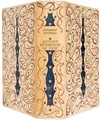This article focuses on essays (stamps that were designed but never issued), describing various designs and noting some of the ways the government tried to prevent stamp reuse in the late 1800s. It originally appeared in the December 1943 issue of American Collector magazine, a publication which ran from 1933-1948 and served antique collectors and dealers.
It was a shock to the Bureau of Engraving and Printing when a critic pointed out that the view of “Gatun Locks,” which it had engraved and so titled on the design for the two cents red Panama-Pacific Exposition stamp of 1912, was really a picture of San Pedro Miguel Locks. Plates had been made from the die, and hundreds of thousands of stamps were printed. Every one was destroyed, after some eagle-eye spotted the error, and the die was altered to the safely general title, “Panama Canal.”

A 1914 Peace Commemorative: Outbreak of World War I prevented this essay becoming a stamp to hail one hundred years of Anglo-American peace.
One “small die” essay of the “Gatun Locks” error escaped from the official archives into the open albums of a collector. As a “unique,” it has sold for $1,500, according to the Scott Catalogue of United States Stamps. No other essay ever brought more than $500.
“An essay is a design for a stamp submitted to a government for approval, and not accepted, nor issued, in the detail design,” to quote Clarence W. Brazer, who wrote the catalogue, “Essays for U. S. Adhesive Postage Stamps,” and is considered the leading American authority on the subject.
Curious reasons sometimes caused an essay’s rejection. The thirty cents design submitted by the National Bank Note Co. for the 1869 series involved an exquisite engraving of John Trumbull’s painting of Burgoyne’s Surrender at Saratoga. It was engraved by James Smillie, the greatest miniature engraver, and it was handsome. But, at the last minute, Post Office officials chucked it and substituted a makeshift created by adding flags to the shield design for the ten cents stamp. They were afraid of offending the British who only recently had been sympathizing with the Confederates.
This Burgoyne essay is a favorite with Dr. Brazer. He likes to point out that in 1927, when the United States celebrated the bicentenary of the Battle of Saratoga, the Trumbull oil painting was chosen for reproduction on a two cents commemorative stamp, but no living engraver could reproduce the Smillie job. The 1927 “Surrender” was four times as large and lacked the depth of Smillie’s.
Unfamiliarity with aeronautics in 1912 led to the spurning of the first essay engraved for the twenty cents parcel post stamp, showing “Aeroplane Carrying Mail.” The creaking Wright biplane was supposedly soaring through the blue with sheer air and a few housetops beneath it. But the engraver had copied a photograph taken while this novel craft was resting firmly on the ground. The aviator’s feet were off the controls and waving in the air, and the all-important mail bag was carelessly dangling below the lower wing, instead of being securely lashed higher in this windy crate. The faulty design was corrected and the stamp issued.

Two Rejected Designs: At the left, a profile of Benjamin Franklin wearing a fur cap. At the right the Surrender of Burgoyne which was turned down in 1869 to avoid offending Great Britain.
Heads were engraved first in the essays for the 1870 stamps, and submitted for the approval of the Postmaster General, who took them along to one of Grant’s cabinet meetings. The cabinet members criticized the way Lincoln’s hair was brushed, the length of Webster’s “Burnsides,” and so forth. So the National Bank Note Co. had to recomb Abe’s hair forward instead of back, and trim the Webster whiskers. The portraits were sculptured in this series and it was hard to find satisfactory busts of all the men. The head of Edward M. Stanton, Lincoln’s Secretary of War, had to be engraved in a marble effect from a photograph of this statesman for the seven cents stamp.
In the 1890 designs, the Lincoln and Grant heads proved the hardest. Three engravers had to do the heads of Lincoln for the four cents stamp, and four heads of Grant had to be done for the five cents stamp, before the critics were suited. The portraits of these two men were so well known that the likenesses had to be those most familiar to the public.
When a hundred years of Anglo-American peace had rolled by in 1914, the Post Office Department prepared to issue two stamps for the centenary. England and Canada also planned “peace stamps.” Out of several essays submitted, Postmaster General Burleson had okayed one for a two cents, another for a five cents stamp. They were symbolic, with Britannia and America holding flags and clasping hands across a globe for the two cents stamp, and the Spirit of Peace, with a dove before her, on the five cents. Both designs included “Peace” and “1814-1914.”
The newspapers had hardly run the peace stamp story when Germany and France went to war, and England and America were soon in the melee, so the idea was abandoned and the two designs filed away in appropriate vaults. Three sets of the essays got out, however, and today they are much sought items.

A Patented Coupon Essay: Above the proposed stamp bearing a profile head of Franklin is an ungummed coupon which was to be torn of by postal clerks as part of cancellation. At the right an 1870 essay with engraved head of Lincoln and water color frame. This was adopted, with slight variations, for a six cent stamp.
Another war explains the rejection of the handsome bi-colored essays for the Trans-Mississippi Exposition stamps. In 1898, postal officials planned an elegant series with black centers and different colored frames. But the outbreak of the Spanish-American war overburdened the Bureau of Engraving and Printing with the task of printing bales of bonds and revenue stamps. So the bi-coloring was dropped, and the stamps came out in single colors. However, collectors got their hands on about 200 sets of bi-colored “large die” essays, and have raved over their beauty ever since. A full set of nine sells today for $75.
Many essays are unique, including all the drawings of designs. Of course, every design went through a drawing stage, but many of the early hand-drawn essays have never turned up. All the stamp models, which are assemblies of parts of previously made engravings, sometimes with drawing to complete the design, are unique, too. So collector competition is fairly keen. The unique items are worth $100 or more, and any large die essay or proof since the 1901 issue is worth at least $100, says Dr. Brazer.
Die essays are very rare because never more than ten were made, and usually only from two to six. Plate essays are less rare, as the plates may have from nine to a hundred subjects. Sometimes only one print was made from the plate in any particular color.
What really inspired Dr. Brazer to collect essays was a set of four progressive die proofs pulled for the engravers during the preparation of an essay by Toppan, Carpenter & Co. for the twenty-four cents red-lilac Washington-head stamp of 1860-61. The sequence showed how stamp designs are built up through the work of several craftsmen.

Tammany and Liberty: Chief Tammany appeared on a wood-cut early in the 186os. The head of Liberty with postage misspelled portage caused this essay to be reengraved but even then it was rejected.
First came the oval portrait vignette, engraved by J. I. Pease. The next proof showed the addition of an inner frame of square lettering, engraved by Henry Earle. In the third proof, a third engraver had added the geometric lathe work of the outer frame, and in the fourth proof numerals had been added in the four corners, and the portrait engraver had gone over Washington’s head to touch it up a bit. None of these engravers could have done the whole job, as each was a specialist. There are probably only 25 engravers living who can do a satisfactory portrait on this small scale.
For many years the picture of Ben Franklin in a fur cap on the earliest known American stamp essay was thought to be Robert Fulton. This essay was engraved in 1847 by Gavit & Co. of Albany for the proposed Albany Postmaster’s stamp which was never issued because the federal government put out its first stamps that year. In 1851, this firm, desiring to submit an essay for the three cents 1851 stamp, cut off the borders of its earlier essay and engraved new top and bottom labels. But it failed to get the contract.
Edward H. Mason, the noted essay student who died in 1912, listed the head as Fulton’s in his catalogue, but Dr. Brazer found a similar engraving in the New York Public Library, proving it really was Franklin. The portrait was from a bas-relief made by an Italian sculptor in Paris.
The unillustrated Mason book had been the essay collectors’ sole guide from 1911 until 1941 when the Brazer catalogue appeared, incorporating all the essays which had turned up in the intervening thirty years.

A Wrong Airplane Design: This essay was engraved from a photograph of an airplane taken on the ground, so it has the aviator's feet of the controls and mail pouch dangling perilously near his head.
The hard times during and after the Civil War led many citizens to try to use postage stamps a second time, and postal officials believed a great deal of revenue was being lost. So, when they advertised the 1867 stamp printing contract, they asked for essays which would stump the re-users and counterfeiters. Some odd ones turned up.
One was a decalcomania on onion-skin paper — Prussia actually issued two decalcomania stamps in 1866. On another essay, the paper was pierced with S-shape scroll cuts. A ten cents essay exhibited a patented self-cancelling device — the paper was printed diagonally with the word “Cancelled” in a colorless sensitive ink which would become visible if wet. You cancelled this one with a sponge.
Another scheme to stymie the re-users was shown in an essay with a fold in the middle which postal clerks were supposed to rip out. And there was one with an ungummed coupon attached to the stamp reading: “Stamp of no value without Coupon. Coupon to be removed only by the Postmaster.”
Some were printed in rainbow colors in fugitive inks. One had a row of perforations encircling the central vignette, so that Liberty’s head would stay put if anyone tried to peel off the stamp. And there were several stabs at using the George T. Jones patent for overprinting or underprinting the designs with network screens in sensitive inks of various colors — the Bureau of Engraving and Printing was then using this trick on beer tax stamps.
When it came to the Columbian issue of 1893, photography proved useful. For the six cents essay, a tintype was taken at stamp size of a panel of the Randolph Rogers bronze door of the Capitol. The engraver cut the outlines on the tintype, filled the cuts with red wax and transferred the design to the die’s surface. Proofs taken from that tintype exist.

To Foil Stamp Re-Users: At the left an essay with patented wavy-line overprinting, done with sensitive ink. At the right an oval of perforations surrounding the Liberty head to make re-use of this proposed stamp practically impossible.
Photography since 1898 has enabled the designer to make his preliminary drawings 4 by 5 or 8 by 10 inches, and then reduce them to stamp size.
The essays may be the unsuccessful attempts of the stamp maker, but to collectors they tell the story of a stamp’s development, and have an appeal all their own.
Of all the odd experimental methods offered to foil the re-users and counterfeiters, only one was adopted — the grill, or little rectangle of embossed bumps, which cut the paper so the ink would not wash out. Grills were applied to the stamps of 1867, 1869, 1870-71 and to the 1873 and 1875 issues.
One of the more curious essays for United States stamps was evolved in 1869 to tie in with a novel bond-issuing plan. Instead of issuing bonds with the interest payable as usual by coupons every six months, it was proposed to make the interest 3.65 per cent, so that a hundred dollar bond would earn three cents a day. This interest was to be payable in 365 postage stamp coupons, every one bearing a different date. Each day the bondholder could tear off a coupon and use it to mail a letter — or he could use it at any time after its date.
The plan seemed so feasible that a few bond-books of these coupons were engraved and printed as essays, though not all of the 365 coupons were completely engraved. Congress, however, soon discovered that these little green postage stamp interest coupons would jam the bookkeeping between the Treasury and Post Office Departments, so it did not pass the enabling legislation.

Stages in Engraving the Twenty-four Cent Head of Washington Design: Left to right, the oval portrait copied from Gilbert Stuart, with lettering surrounding the portrait, geometric lathe engraved frame, and at right, the completed design with 24 engraved in each corner.
This article originally appeared in American Collector magazine, a publication which ran from 1933-1948 and served antique collectors and dealers.
 NASCAR Model Cars, from AMT to Revell
NASCAR Model Cars, from AMT to Revell Made for Misfits: The Colorful History of the Black Leather Jacket
Made for Misfits: The Colorful History of the Black Leather Jacket Where the Wild Books Are
Where the Wild Books Are Take That, Instagram: The Enduring Allure of Vintage Snapshots
Take That, Instagram: The Enduring Allure of Vintage Snapshots At Home With Horror: Metallica's Kirk Hammett Embraces His Inner Monster
At Home With Horror: Metallica's Kirk Hammett Embraces His Inner Monster StampsThe world’s first adhesive postage stamp was the Penny Black, printed for t…
StampsThe world’s first adhesive postage stamp was the Penny Black, printed for t… Mari Tepper: Laying it on the Line
Mari Tepper: Laying it on the Line Nice Ice: Valerie Hammond on the Genteel Charm of Vintage Canadian Costume Jewelry
Nice Ice: Valerie Hammond on the Genteel Charm of Vintage Canadian Costume Jewelry How Jim Heimann Got Crazy for California Architecture
How Jim Heimann Got Crazy for California Architecture Modernist Man: Jock Peters May Be the Most Influential Architect You've Never Heard Of
Modernist Man: Jock Peters May Be the Most Influential Architect You've Never Heard Of Meet Cute: Were Kokeshi Dolls the Models for Hello Kitty, Pokemon, and Be@rbrick?
Meet Cute: Were Kokeshi Dolls the Models for Hello Kitty, Pokemon, and Be@rbrick? When the King of Comedy Posters Set His Surreal Sights on the World of Rock 'n' Roll
When the King of Comedy Posters Set His Surreal Sights on the World of Rock 'n' Roll How One Artist Makes New Art From Old Coloring Books and Found Photos
How One Artist Makes New Art From Old Coloring Books and Found Photos Say Cheese! How Bad Photography Has Changed Our Definition of Good Pictures
Say Cheese! How Bad Photography Has Changed Our Definition of Good Pictures Middle Earthenware: One Family's Quest to Reclaim Its Place in British Pottery History
Middle Earthenware: One Family's Quest to Reclaim Its Place in British Pottery History Fancy Fowl: How an Evil Sea Captain and a Beloved Queen Made the World Crave KFC
Fancy Fowl: How an Evil Sea Captain and a Beloved Queen Made the World Crave KFC
Leave a Comment or Ask a Question
If you want to identify an item, try posting it in our Show & Tell gallery.